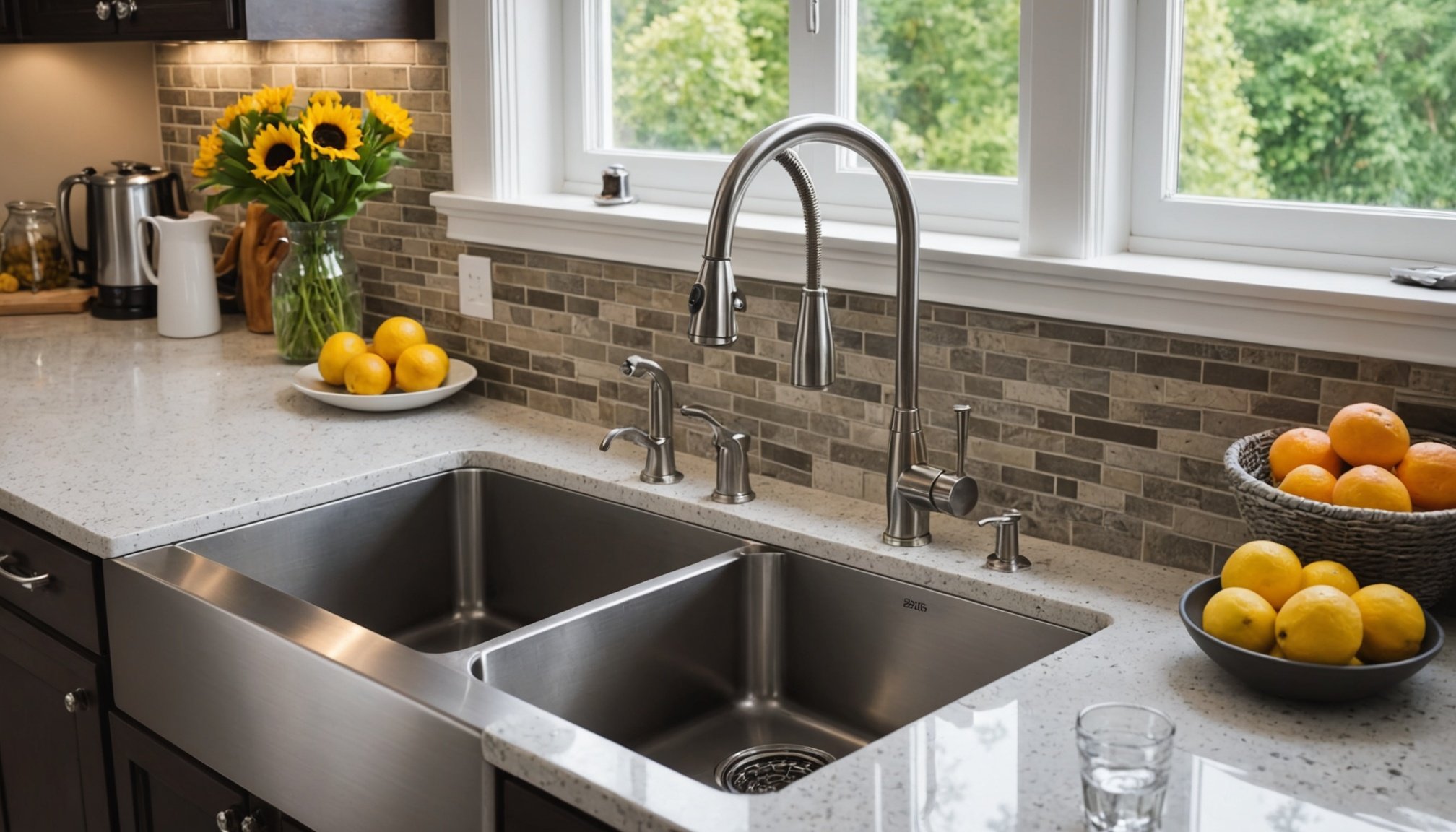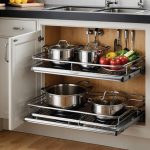Understanding Family Needs for Kitchen Sink Selection
When choosing a kitchen sink, consider the kitchen sink size carefully, as it greatly impacts daily efficiency, particularly for different family needs. To start with, family requirements play a crucial role in guiding the right decision. For smaller households, a single-bowl sink might serve well. However, larger families often benefit from a double-bowl sink to accommodate multiple users and bigger dish loads.
The daily usage and activity level also determine the needed sink size. Busy households with frequent cooking sessions and large meal preparations usually demand a more spacious sink to fit pots, pans, and other cookware efficiently. If your lifestyle involves hosting gatherings or batch cooking, ensure your sink can manage these activities seamlessly.
Topic to read : Designing the ideal kitchen island with a built-in pet bed: an innovative guide for pet enthusiasts
Furthermore, the lifestyle and cooking habits of households significantly affect sink choices. Families who prioritise quick and less elaborate meals might find a smaller sink adequate, while gourmet cooks who enjoy experimenting need a bigger space to wash fresh ingredients and clean up. Your sink should adapt to these habits, accentuating both functionality and comfort in your kitchen. Understanding these needs ensures a kitchen sink not only fits perfectly into the kitchen layout but also into the family’s lifestyle.
Measuring Kitchen Space Properly
Determining the right kitchen sink size requires precise planning. Whether your kitchen is small or expansive, accurate measurements are paramount.
Also to read : Elevate your cooking space: unlocking energy savings in smart kitchen designs during high demand hours
Key Measurements for Sink Installation
Begin by identifying key measurement parameters for sink installation. Measure the kitchen layout to determine the maximum and minimum dimensions your sink can accommodate. Additionally, factor in the depth and shape of your countertop, as these impact the sink’s overall positioning.
Considerations for Countertop Space
When evaluating countertop space, consider the areas required for other kitchen amenities. The relationship between the sink and workstations like your stove or cutting area is crucial for a fluid workspace. This balance ensures that the sink installation doesn’t impede daily kitchen tasks.
Relationship Between Sink Size and Cabinet Dimensions
Furthermore, align your sink size with existing cabinet dimensions. A seamless fit not only enhances your kitchen’s aesthetic but also optimises storage beneath the sink. For accurate measurements, one might consult a professional to ensure compatibility and avoid potential issues during installation.
Understanding these elements reinforces the functionality and visual appeal of your kitchen space, affording you a truly customised and efficient setup.
Recommended Sink Sizes for Different Family Scenarios
Selecting the right sink dimensions is essential to meet varying family needs. For smaller families, a compact single bowl sink often suffices, optimising limited kitchen space while meeting basic washing requirements. In contrast, larger families or those with active kitchen use benefit from a broadened sink with double bowls. This setup is often advantageous for multitasking, such as washing and rinsing simultaneously.
In households where multiple cooks engage in preparing meals, consider larger sinks to accommodate increased activity levels without hindrance. Adaptations like double or even triple bowl sinks can significantly enhance kitchen efficiency, catering to shared cooking responsibilities.
Picture a scenario where a family loves hosting dinners. A thoughtful sink choice, perhaps larger with special features like integrated drains or cutting boards, can balance the load. This tailored solution ensures the kitchen functions well during busy gatherings and preparation phases.
Ultimately, tailoring sink dimensions based on specific family scenarios not only supports functionality but also enhances the overall kitchen experience. Thus, consider these recommendations carefully in order to select a sink dimension that seamlessly fits the family’s unique needs and lifestyle.
Style and Material Considerations for Sinks
Choosing the right sink materials and style is crucial, as it impacts both functionality and aesthetics in your kitchen. Various materials offer distinct benefits, making this decision a significant one.
Popular Sink Materials and Their Benefits
- Stainless steel sinks are favoured for their durability and resistance to stains or heat. Their sleek, modern appearance suits many kitchen designs.
- Porcelain sinks exude a classic elegance, available in numerous colours, though they may chip over time if not carefully handled.
- Composite sinks, made of materials like granite or quartz, provide a robust, scratch-resistant surface and add a touch of sophistication to modern kitchens.
How Design Affects Sink Functionality
The design can greatly influence sink usability. Features like integrated drainer boards or multi-level basins enhance washing efficiency by facilitating better water flow and space management. Thus, design considerations are crucial in ensuring functionality aligns with lifestyle needs.
Matching Sink Style with Kitchen Aesthetic
Incorporating your sink into the kitchen aesthetic fosters a harmonious environment. Style cohesion involves aligning sink colours and finishes with existing décor, creating an integrated, visually appealing space. This can transform your kitchen into a unified design masterpiece, effortlessly merging functionality with style.
Practical Examples and Case Studies
Considering real-life case studies offers valuable insights into the complexities of choosing the right kitchen sink. Families often face challenges like achieving the ideal balance between meeting kitchen family requirements and maintaining a functional space. Here are some practical examples illustrating various decision-making processes.
For instance, a small family in an urban apartment opted for a compact kitchen sink size with a single bowl. This choice maximised their limited kitchen space while meeting their daily usage needs, like simple meal preparations. Their decision prioritised efficiency over size, highlighting the importance of adapting to spatial constraints and lifestyle preferences.
Contrastingly, a family of five with a busy household selected a larger, double-bowl sink. This sink size recommendation was based on their need for multitasking with extensive cookware. Their story illustrates how understanding family scenarios can aid in choosing a sink that supports hectic, multifaceted daily activities.
Through these examples, it’s evident that a tailored approach, focusing on family needs and sink dimensions, can lead to successful kitchen sink installations. These lessons in adaptability and precision reveal how varied kitchen sink choices can be.
Frequently Asked Questions
When pondering a kitchen sink size, common concerns span various aspects of functionality and practicality.
Common Concerns About Sink Size
What is the ideal kitchen sink size for my household? Precision here is key. Begin by examining your family size and typical usage patterns. A compact single-bowl sink often suits small families with minimalist washing habits. Meanwhile, larger households focusing on multitasking benefit from double or triple-bowl options. The right fit reduces daily hustle by enhancing efficiency and comfort.
Addressing Installation Issues
How can I ensure the sink installation goes smoothly? Correctly measuring your kitchen layout and considering cabinet dimensions are crucial steps. During sink installation, account for countertop depth and adjacent appliances to prevent spatial issues. Engaging a professional can ensure precision, sparing you future headaches.
Tips for Maintaining Different Sink Materials
What are the best maintenance practices for various sink materials? Stainless steel sinks are durable but require regular drying to prevent water spots. Porcelain demands gentle cleansing to avoid chipping, while composite sinks benefit from mild non-abrasive cleaners. Maintenance routines tailored to material type significantly prolong a sink’s aesthetic and functional life.











